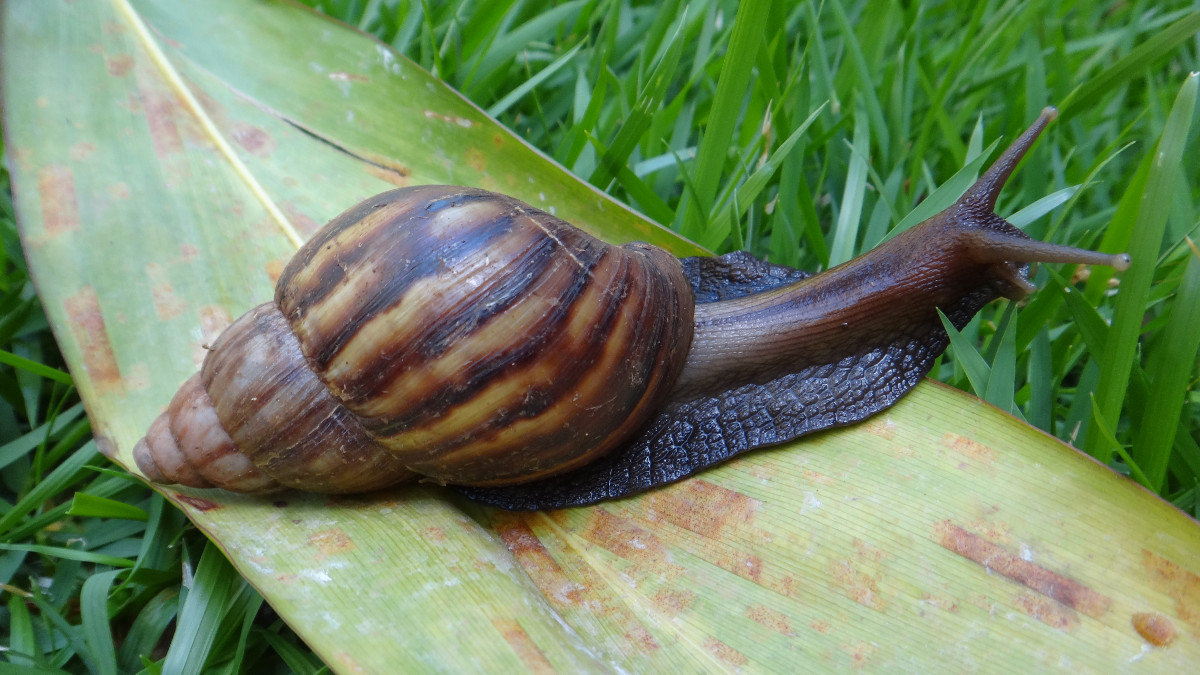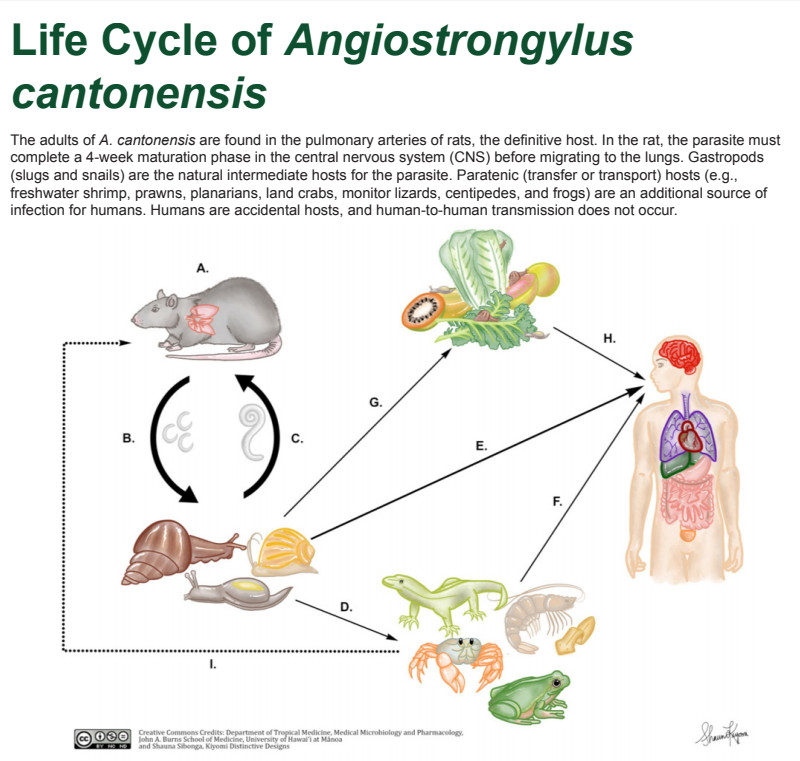(BIVN) – Preliminary guidelines for the clinical management of angiostrongyliasis, more commonly known as rat lungworm disease, have been announced by a special task force assembled to fight the disease in Hawai‘i.
Governor David Ige’s Joint Task Force on Rat Lungworm Disease, appointed in 2016 to advise him and Hawaii’s medical professionals about how best to deal with this illness, have created the new guidelines, which “may be used by Hawai‘i physicians immediately and provide clear diagnosis, treatment, and management guidance for timely identification and care for patients who have contracted the disease.”
The preliminary guidelines will be presented to a national audience during the Annual Meeting of the American Society of Tropical Medicine and Hygiene in November. There will also be a symposium on the diagnosis and management of the disease on October 10 at Hilo Medical Center.
According to the 16 “Key Points” listed in the guidance document, (emphasis added by BIVN):
1. Clinicians in Hawaii should have a high index of suspicion for neuroangiostrongyliasis.
2. Typical symptoms in adults include severe headaches, neck stiffness, nausea, paresthesias, and limb pains. Highly suggestive symptoms include migratory hyperesthesias, cranial nerve abnormalities, ataxia, and focal neurologic fndings which are migratory or do not follow a dermatomal distribution.
3. Typical symptoms in children include fever, abdominal pain, vomiting, irritability, poor appetite, muscle weakness, fatigue, and lethargy.
4. Lumbar puncture (LP) is an essential part of the evaluation of suspected neuroangiostrongyliasis. It is a low-risk procedure and has therapeutic benefts, including relief of headaches, nausea, and vomiting.
5. A presumptive diagnosis of neuroangiostrongyliasis requires all three of the following: a.) A history of suggestive symptoms and signs, b.) Evidence of eosinophilic meningitis in the cerebrospinal fuid (CSF), and c.) An exposure history, which includes residence in or recent travel to an endemic area.
6. Eosinophilic meningitis is the hallmark of the disease and is defned as the presence of 10 or more eosinophils per µL of CSF and/or eosinophils accounting for more than 10% of CSF white blood cells when there are at least 6 total WBC per µL in CSF.
7. CSF eosinophil counts may be absent or low early in the course of the disease, requiring repeat LPs if neuroangiostrongyliasis is still suspected.
8. Real-time polymerase chain reaction (RTi-PCR) of CSF for A. cantonensis DNA is the best way to confrm the infection and is available in Hawaii through the DIB or from the Centers for Disease Control and Prevention (CDC) for the rest of the United States. CSF RTi-PCR may be negative in the early stages of infection. Repeat LP and testing is indicated if neuroangiostrongyliasis is still suspected.
9. Baseline studies should include a complete blood count (CBC) with differential, serum electrolytes, liver function tests, renal function tests, blood glucose, urinalysis, and chest x-ray.
10. Peripheral eosinophil counts of ≥ 500 cells/µL are often present during the course of the illness but may be absent.
11. Magnetic resonance imaging (MRI) of the brain, although not required, may be helpful in diagnosing suspected neuroangiostrongyliasis. Focused MRI of the spine may be appropriate if indicated by clinical presentation.
12. Serological tests for antibodies against A. cantonensis in the serum or CSF are not recommended for the diagnosis of neuroangiostrongyliasis.
13. High dose corticosteroids have been shown to improve clinical outcomes. Start corticosteroids as soon as a presumptive diagnosis of neuroangiostrongyliasis is made and assuming no contraindications. Individuals with diabetes or glucose intolerance should be closely monitored. Modifcations to the patient’s diabetes medications may be needed.
14. The addition of albendazole, an anthelminthic drug, may provide additional benefts, although there is limited evidence of this in humans. If albendazole is used, combine with corticosteroids to blunt any possible increase in the inflammatory response to dying worms.
15. Careful clinical monitoring is recommended in all patients, and specialist consultation (e.g., infectious disease, neurology, etc.) may be advisable.
16. Pain management may require early consultation with a pain specialist.
From the Department of Health media release:
“One of the top priorities of the Joint Task Force has been to develop sound, evidence-based guidelines for physicians to use in diagnosing and treating angiostrongyliasis,” said Kenton Kramer, Ph.D., chair of the Joint Task Force and associate professor of the Department of Tropical Medicine, Medical Microbiology and Pharmacology with the University of Hawai‘i John A. Burns School of Medicine (UH-JABSOM). “The Clinical Subcommittee, made up of expert physicians and specialists from across the state, spent the last year researching and consulting with national and international specialists on the disease to carefully craft the new guidelines.”
Vernon Ansdell, M.D.—an associate professor at UH-JABSOM and physician with more than 45 years of experience specializing in internal and tropical medicine—spearheaded the effort and chaired the Clinical Subcommittee. “Prior to the extensive work completed by the subcommittee, there were no clear, reliable diagnosis and treatment protocols available to Hawai‘i physicians for this potentially serious and debilitating disease,” said Dr. Ansdell. “Diagnosing angiostrongyliasis can be problematic because patients infected with the parasite do not always present the same symptoms. These preliminary guidelines provide critical guidance to physicians to help them make timely and accurate diagnoses and give their patients the best possible treatment available. Our next step is to offer physician training in all counties to increase awareness and understanding of this complex disease.”
Members of the Clinical Subcommittee will be offering Continuing Medical Education (CME) courses through UH-JABSOM in all counties, starting in Hilo on Hawai‘i Island on Oct. 10. CME courses will also be offered on Maui, Kaua‘i, and in Honolulu in early 2019 with the schedule and more details to be announced later this year. For information on the CME courses, go to http://manoa.hawaii.edu/tropicalmedicine/?page_id=3783.
“Updating and improving the guidelines for physicians to better diagnose and treat rat lungworm disease is a major accomplishment for the Joint Task Force,” said Health Director Dr. Bruce Anderson. “We are excited to be a partner in this process and look forward to supporting this project as the guidelines move toward publication and national recognition.”



by Big Island Video News8:40 am
on at
STORY SUMMARY
HAWAII ISLAND - The Governor’s Joint Task Force today released treatment guidelines for rat lungworm disease in Hawai‘i.